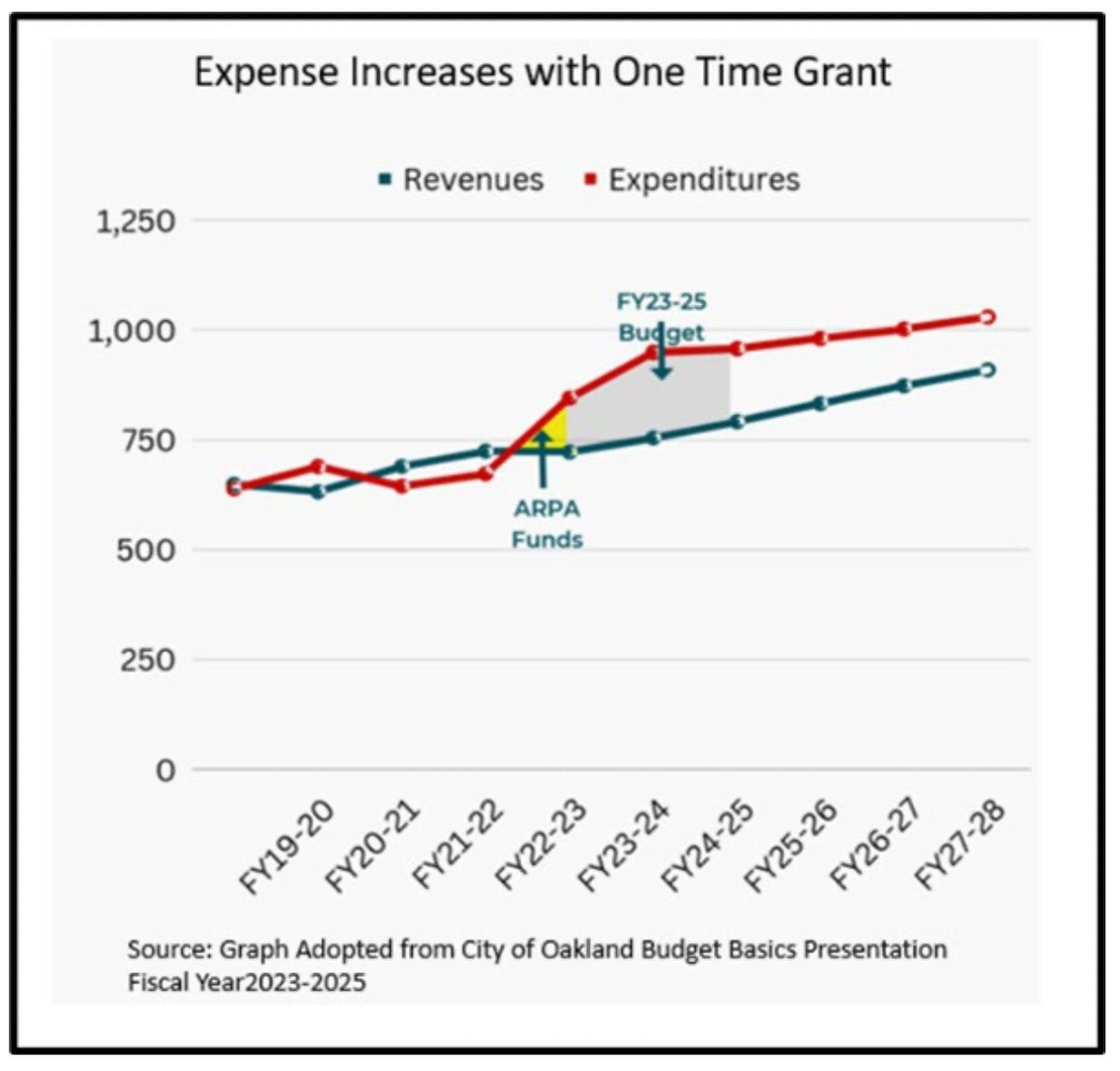Oakland’s 2024-2025 budget squanders the city’s future
The City delays dealing with its ongoing deficit; instead it aims to pay its bills by selling $105M of public assets and diverting restricted funds from voter-approved ballot measures
This year’s budget cycle has been a difficult one. In March of this year, the City forecasted a $177M deficit for this year (ending June 2024) and a projected $175M deficit for the forthcoming year (ending June 2025).
The deficit is in the General Purpose Fund (GPF), which is one third of the City’s $2.2B annual budget, and constitutes its sole discretionary spending account. It pays for 90% of Fire and Police and a major portion of other departments including the Mayor, Violence Prevention, Parks & Rec, Human Services, Auditor, Animal Services, and Finance.
Everyone was bracing for a storm. And, indeed, we got a head-spinning tornado.
Since March, the City froze hiring and set cost-cutting targets >20% across all departments. The Police Department was asked to cut $82.6M, and the Fire Department was asked to cut $47M. Then the Mayor delayed the proposed budget by three weeks. And in a plot twist at the end of May, she backed-off the austerity measures in her proposed FY24-25 budget. The Mayor announced that the severe cuts won’t be necessary because the City had a commitment from the African American Sports and Entertainment Group to buy the City’s half of the Coliseum for $105M.
As the dizziness subsided and the public began to inspect the details (more than 100 public speakers joined the June 12 City Council meeting), cracks in the edifice began to appear. Obviously, $105M from a land sale does not solve a $352M two-year deficit. And the Mayor’s claim to avoid Public Safety cuts is not correct.
Three basic questions have emerged:
How did the City close a $177M deficit for this year (FY23-24) and a $175M deficit for next year’s budget (FY24-25) with no layoffs?
What is the anticipated impact to City services?
Did the City finally fix its long-standing annual deficit (a “structural deficit”), or will we be right back at this again next year?
The short answer is that the City did not solve the structural deficit. In fact, it didn’t even attempt to solve it. It only made one-time financial maneuvers to buy some time.
The City aims to sell $105M of public land (the Coliseum) and use it for operating expenses. This is against directives of the Consolidated Fiscal Policy and prior Council commitments, including a recent reaffirmation of that commitment from Council President Bas in 2022, and will require Council approval this month.
The City diverted over $30M of voter-approved ballot measures to pay operating expenses, thereby suspending the City improvements that voters intended. (See page 16 here, and a discussion between Council Member Reid and Budget Administrator Johnson here and here at the June 12 Council meeting.)
The City cancelled $30M of carry-over expenses from prior years. These are previously promised but never delivered service commitments including election funding, murals, Lake Merritt maintenance, and business corridor cameras.
The City spent the last $93M of the GPF balance, which is the last remaining COVID relief money, as well as spending down the remaining balances on several ballot measure funds (see details here).
The City slashed 100 police positions, 72 fire positions including 9 inspectors, and 28 public works positions (see page 10 here). It is letting the sworn officer count decline over the next six months to 678 from the current level of 712 officers.
The last part—the staffing cut—was necessary for two reasons: (1) overall City employee compensation has risen faster than inflation for the past 6 years (download data summary), while revenues have grown slower than inflation (analysis); and (2) the City expanded its administrative and social service programs dramatically over the past four years using COVID relief money, but never had a long-term plan to pay for them with commensurate revenue growth. Sacrificing public safety positions has become a kind of ‘piggy bank’ to pay for this spending growth in the absence of economic growth.

As Mr. Johnson noted in the June 12 City Council meeting, these severe actions still leave us with an unresolved ongoing deficit of more than $100M:
“Tentatively we think that the structural deficit in the General Purpose Fund is in excess of $100 million dollars in each of the coming fiscal years. So we do have a structural problem, we will need to address that. And that will mean we will need to make hard decisions regarding the expenses that the city can afford.” [link]
“We need to get to a fiscal plan, which is what the City Administrator has tasked us all with beginning this fall, that structurally balances our budget. That means making permanent adjustments to our revenues and expenditures on an ongoing basis. That means we do not have rolling and ongoing deficits.
And it would include restoring the maintenance of efforts and all those ballot measures because that cannot be done indefinitely. We have to move past using one time resources, land sales fund balances to ensuring that resources coming in equal expenses going out and that is the task that we need to undertake beginning the September.” [link]
So yes, we’ll be right back at this in less than a year.
Let’s put this even more simply: the City postponed spending cuts that we’re going to have to make in the coming year anyway. This delay is driven partly by the Administration’s refusal to acknowledge the elephant in the room—unaffordable labor compensation increases that exceed inflation, and unaffordable growth in social service and administrative spending since 2018.
This delay in fiscal discipline is causing us to squander $105M that could have been used to invest in sustainable community growth and wealth building.1 It is breaking voter trust by commandeering the tax measure revenue for unintended purposes, thereby putting future ballot measures at risk. It is further straining police capacity in this City that already has 31% less police than the national average. This is happening during the City’s exceptional crime wave, thereby jeopardizing the foundation of all other City ambitions. Moreover, we’re not escaping the forthcoming austerity—we’re still going to have to make those delayed cuts next year.
Imagine the lives and livelihoods that could have been transformed with $105M if the City invested it in a venture fund for entrepreneurs in East Oakland. Or imagine how that money might have improved public safety through the acquisition of drone technology and camera systems to replace dangerous police chases. Imagine what the money might have done to improve the aging 911 system, or the crime reporting and investigation software.
We will never know because the City seems to be on an irreversible course of action with its proposed budget. The City will deliver answers to Council questions and a revised budget proposal on June 26, one month late, and only 4 days before the budget deadline. There will be no time for due process, and it forces the City Council to vote with no time to formulate or consider alternatives.
Our understanding of this budgetary reality comes from the City’s raw budget data, obtained from the City’s budget portal. We parsed it and placed it into historical context. We compared the proposed FY24-25 budget (1) to the current FY23-24 budget, (2) to the original budget for FY24-25 (adopted last June), and (3) to six years of historical data. The results of that work are provided in a slide deck here, and accompanying spreadsheets of budget tables and significant changes.
In subsequent posts, we will detail some highlights of the analysis. In the meantime, take a look and post your questions in the comments. We’ll do our best to answer.
Excerpt from East Bay Times, 22 May 2024: “Good elected officials of all stripes know that you should not sell off capital assets,” said David Crane, a lecturer of public policy at Stanford University. “When you sell capital assets, you should use the money for something that produces a benefit for many years.”







Another authentic and much-missed piece of journalism you won't see in the propaganda mills of Oaklandside & Co., the "best burgers" and "legendary pizza parlor closes" nonsense of the Chronicle, or the insipid "Man Crashes Into Tree" filler stories in the East Bay Times. Everyone with a stake in this crumbling city should be reading these non-ideological, verifiable-fact-based stories. Spread the word.
Much appreciated Tim. Send it to the newspapers and TV outlets.